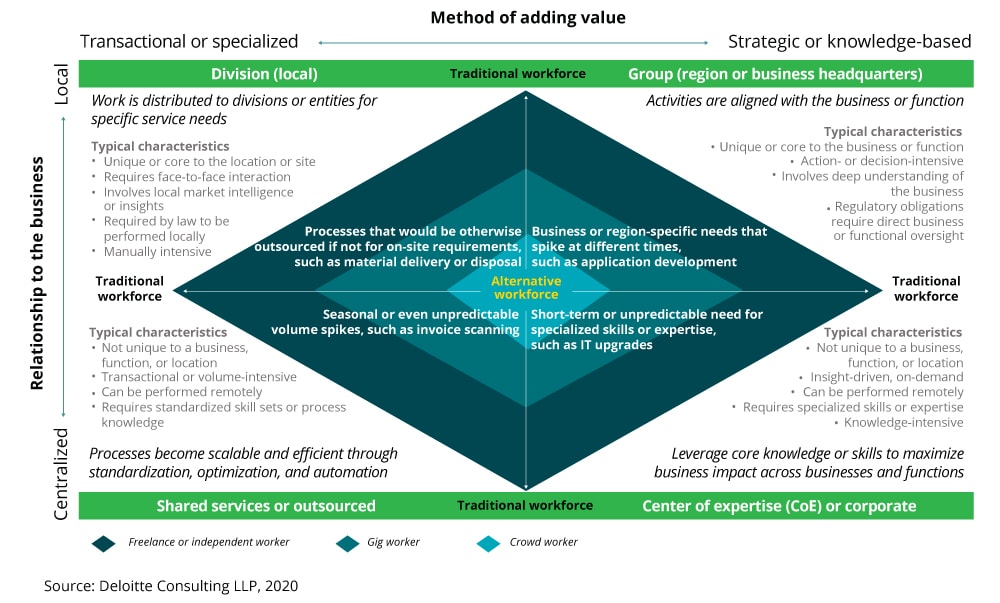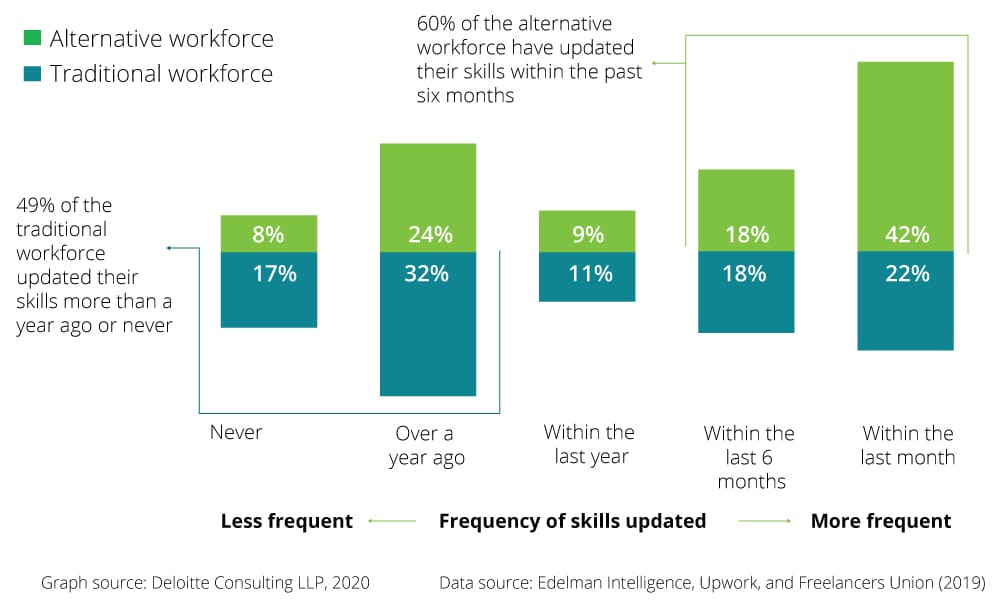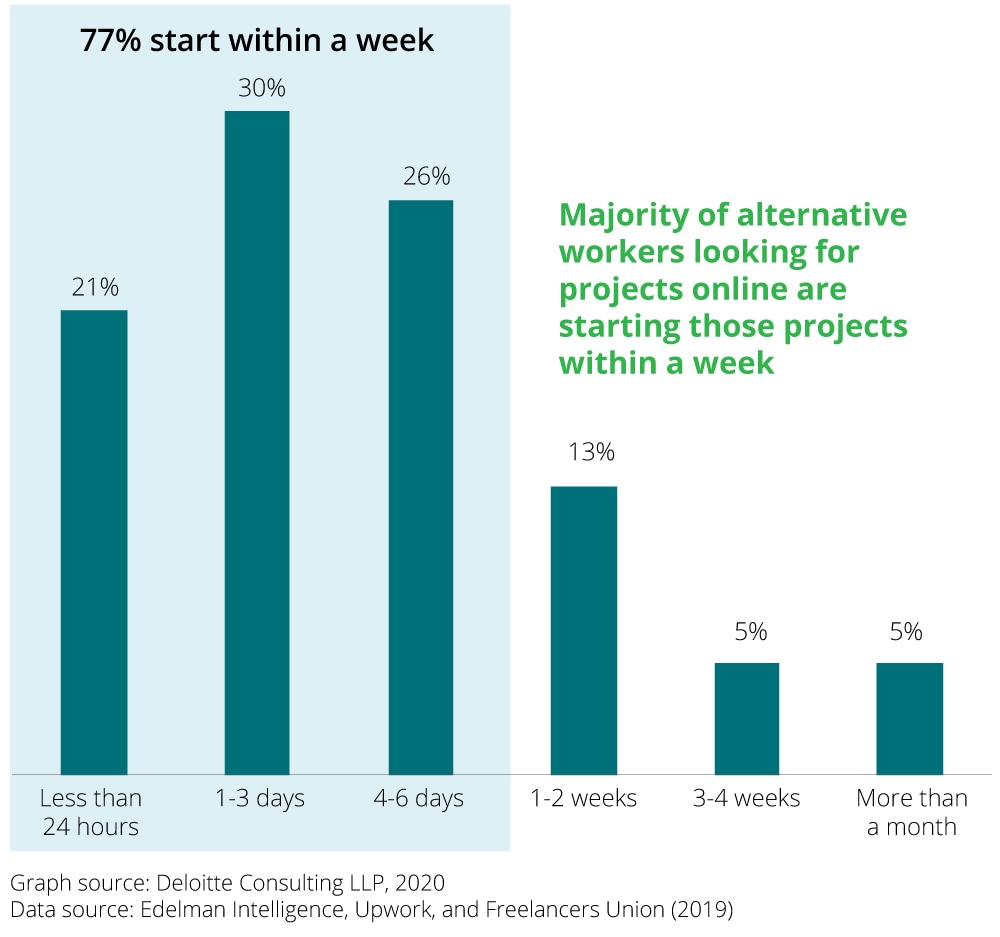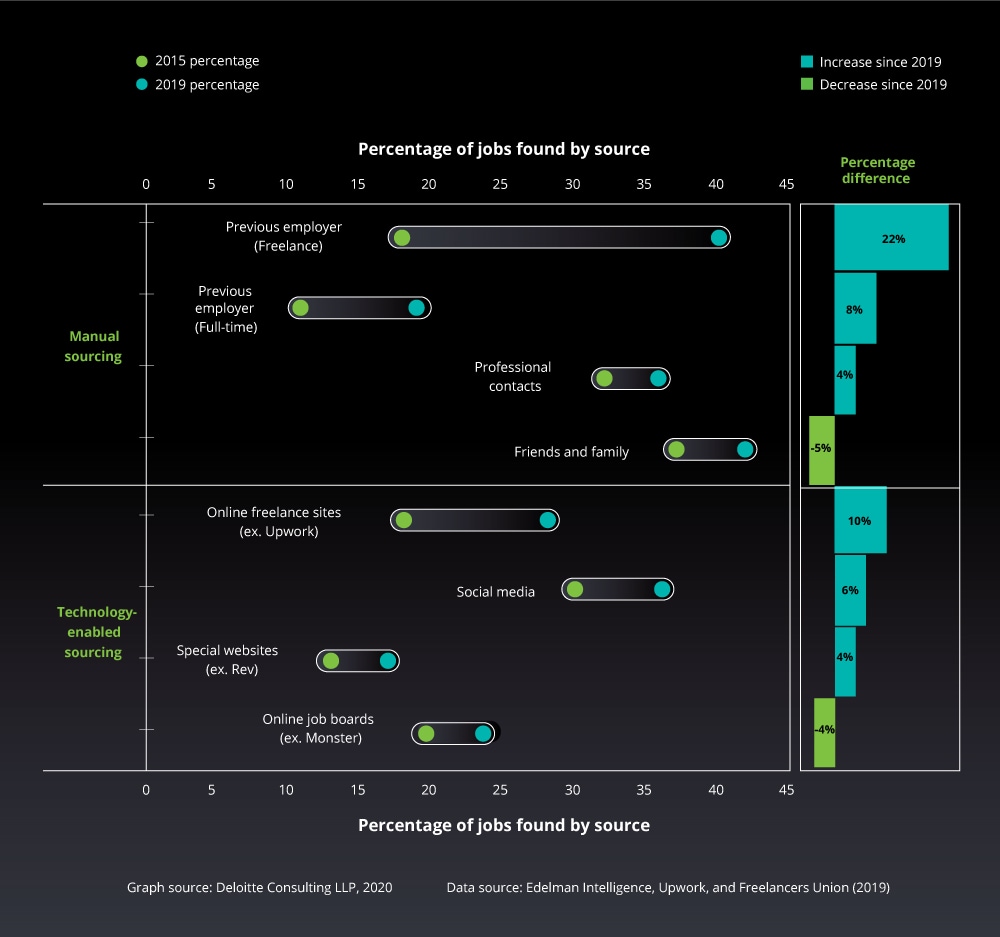The gig economy and future of shared services and GBS delivery models has been saved

Perspectives
The gig economy and future of shared services and GBS delivery models
Alternative workforces: The right talent at the right time
In light of the COVID-19 pandemic, an update to the traditional global business services (GBS) and shared services delivery model is no longer imminent—it’s already here. The alternative, on-demand workforce of gig workers, freelancers, independent workers, and crowd workers presents GBS and shared services organizations with the opportunity to challenge the traditional profile of only full-time employees performing just transactional work. Welcome to the gig economy.
Explore content
- COVID-19 and the future of the gig economy
- The who, the when, the how
- A GBS and shared services delivery model framework in light of alternative workforces
- Benefits of the alternative, on-demand workforce
- Integrating the alternative workforce into GBS and shared services organizations
- Sourcing the gig economy
- Integrating the alternative workforce into the broader enterprise
- Endnotes
- Get in touch
- Join the conversation
COVID-19 and the future of the gig economy for GBS and shared services
What does the alternative workforce and gig economy mean for GBS and shared services organizations in light of COVID-19?
- The COVID-19 pandemic has highlighted the importance of the alternative workforce for helping keep a disrupted economy afloat.
- GBS and shared services organizations may be able to help protect themselves from unpredictable demand by integrating the alternative workforce into their operating model so they can quickly shore up capacity when and where it’s most needed.
- Integrating the alternative workforce also offers options for future business continuity planning.
There are currently 57 million workers participating in the American gig economy, accounting for 36 percent of the US workforce, and this proportion is expected to increase. By 2027, this “alternative workforce” of freelancers, gig workers, and crowd workers is expected to become the majority of the US workforce.1
The rapid emergence of the alternative workforce and gig economy presents a new opportunity to GBS and shared services organizations by providing access to a niche set of skills and burst processing capacity while reducing excess resource capacity. By integrating the alternative, on-demand workforce into their operations, GBS and shared services organizations may have an opportunity to increase the return on talent investments by engaging the right resources at the right time.
The who, the when, the how
A GBS and shared services delivery model framework in light of alternative workforces
Organizations evaluating shared services delivery models along the GBS and shared services spectrum have typically relied on a traditional 2x2 framework with the following axes:
- Relationship to the business, ranging from centralized to local
- Method of adding value, ranging from transactional or specialized to strategic or knowledge-based
For each function in scope for evaluation (such as finance), these organizations would allocate processes (such as cash applications) into each quadrant of the 2x2 framework.
Until now, that framework has been used to primarily answer the questions of “where” and “what” of a GBS or shared services center, but now it’s important to also answer the question of “who.” As the alternative workforce enters in greater numbers into the labor market, the traditional 2x2 will likely require an additional dimension to account for different types of workers.
Click image to enlarge
Benefits of the alternative, on-demand workforce
The alternative workforce tends to update their skills more frequently and can typically ramp up within days rather than weeks. Their long-term success is dependent on staying up-to-date and minimizing time to delivery. In 2019, 60 percent of the alternative workforce reportedly participated in skills or education-related training in the past six months, compared with 40 percent of the traditional workforce. By leveraging this new workforce, GBS centers can achieve new economies of scale while reinventing their operating models to account for an adaptable workforce that continues to grow rapidly in the United States.
Click image to enlarge
The majority of alternative workers looking for projects online are starting those projects within the week. Due to the rapidly changing needs of the environment, alternative workers tend to be more available, as they are dependent on these projects for their primary source of means. Organizations can leverage this adaptable and available workforce as a flexible source of talent to meet ongoing demands.
Click image to enlarge
Integrating the alternative workforce into GBS and shared services organizations
GBS and shared services organizations looking to integrate the alternative workforce will likely need to build new muscle in:
- Identifying the right activities (or “gigs”) to parse out to the alternative workforce
- Developing a new talent model that can effectively source individuals from different hiring pools for the right gig at the right time
- Managing the alternative workforce effectively within the broader GBS and shared services organization
As the alternative workforce deviates from a traditional hiring model, these workers can be leveraged for both transactional and specialized functions. Service delivery within GBS and shared services organizations can be optimized to engage and disengage resources depending on certain levers, such as volume seasonality, specialized knowledge, and entry into new markets.
Through the use of the identified levers, the next steps involve identifying activities within a function that are most appropriate for the alternative workforce. Some activities will still be best performed by a traditional full-time worker. For example, a long-standing customer relationship could be put at risk with a string of contacts varying from one “gig” to the next, compared to a steady point of contact. However, other activities, such as those without a high number of touchpoints and background knowledge, could be candidates for an alternative worker.
Some specific examples of potential activities, organized by function, are:
Click image to enlarge
Sourcing the gig economy
It’s important that GBS and shared services organizations project their resourcing needs and develop resource pipelines for the alternative workforce. While these workers can often join an organization much faster than a traditional worker, predicting the organization’s needs in advance still helps with procuring the worker and skill set the organization needs.
Today, alternative workers can already be sourced through existing online freelancing platforms. However, in reality, many alternative workers still find their next projects through previous clients (word of mouth) and professional contacts. GBS and shared services organizations can develop a robust sourcing system that leverages both their existing network of alternative workers and platforms that are growing in popularity.
Click image to enlarge
Integrating the alternative workforce into the broader enterprise
Organizations should also prepare adjacent enterprise functions to provide infrastructural support for a new workforce with different needs from those of a traditional workforce.
A common benefit of the alternative workforce is that they can join your organization when you need them. But does that mean your IT organization is ready to get them up and running just because the alternative workers are? GBS and shared services organizations will need to work with their enterprise IT function to set expectations and even design an onboarding process that rapidly gets the alternative worker on the network with the right access, including remote access requirements. An equally rapid offboarding process will be important as well.
For each activity to be sourced to an alternative worker, determine whether that worker will be on-site or remote. If on-site, ensure you have open lines of communication with your facilities management and real estate functions so that they can accommodate these workers as soon as they join.
As the workforce size increases with the addition of shorter-term, higher-quantity unique workers, the oversight responsibilities of the organization also increase dramatically. To help keep quality up and fraud risk levels down, risk and compliance functions will need to update their controls to account for the changing workforce structure in their GBS and shared services organization.
Freelancing continues to be a hot topic among state governments, some of whom are actively introducing or tightening laws around co-employment and worker classification.2 While the legislative landscape continues to shift, GBS and shared services organizations should consider, among other things, the appropriateness of the role for an alternative worker and how to best structure any relationship in order to provide valuable experiences and draw high-quality work while also mitigating the risk of co-employment.
Detailed process mapping emphasizing handoffs between specific roles will continue to be a critical component of transition success. This is no different from the typical prerequisite transition activities in traditional process centralizations. Learning and development opportunities that extend to the alternative workforce can contribute to their integration into the organization and interest in subsequent projects in the same organization.3
If the aggregate cost of these infrastructural requirements to support an alternative workforce exceeds the identified benefit of shifting work to an alternative workforce, then consider how to decrease those costs or ultimately decide whether the traditional workforce is still the optimal workforce type for your organization.
For the new workforce to succeed, GBS and shared services organizations should expand their infrastructural support to set up alternative workers for success. Proactive updates to enterprise scalability and risk assessment can provide a more integrated and effective experience for both alternative and traditional workers.
Interested in finding out more?
If your GBS or shared services organization is interested in a pilot to integrate the alternative workforce, please reach out to one of us listed below.
Endnotes
1 Edelman Intelligence, Upwork, and Freelancers Union, “Freelancing in America 2017,” www.upwork.com/i/freelancing-in-america/2017.
2 Alejandro Lazo, “California enacts law to classify some gig workers as employees,” Wall Street Journal, September 18, 2019.
3 Michael Griffiths, Terry Patterson, and Carly Ackerman, Creating value and impact through the alternative workforce: Cultivating an environment of continuous learning to engage the alternative workforce, Deloitte Development LLC, June 25, 2020.
Explore content
- COVID-19 and the future of the gig economy
- The who, the when, the how
- A GBS and shared services delivery model framework in light of alternative workforces
- Benefits of the alternative, on-demand workforce
- Integrating the alternative workforce into GBS and shared services organizations
- Sourcing the gig economy
- Integrating the alternative workforce into the broader enterprise
- Endnotes
- Get in touch
- Join the conversation
Recommendations
Reimagining operating models of the future to thrive
The case for resiliency, adaptability, convergence, and integration
Impact of COVID-19 on shared services and GBS
Captive and outsourcing service delivery implications







